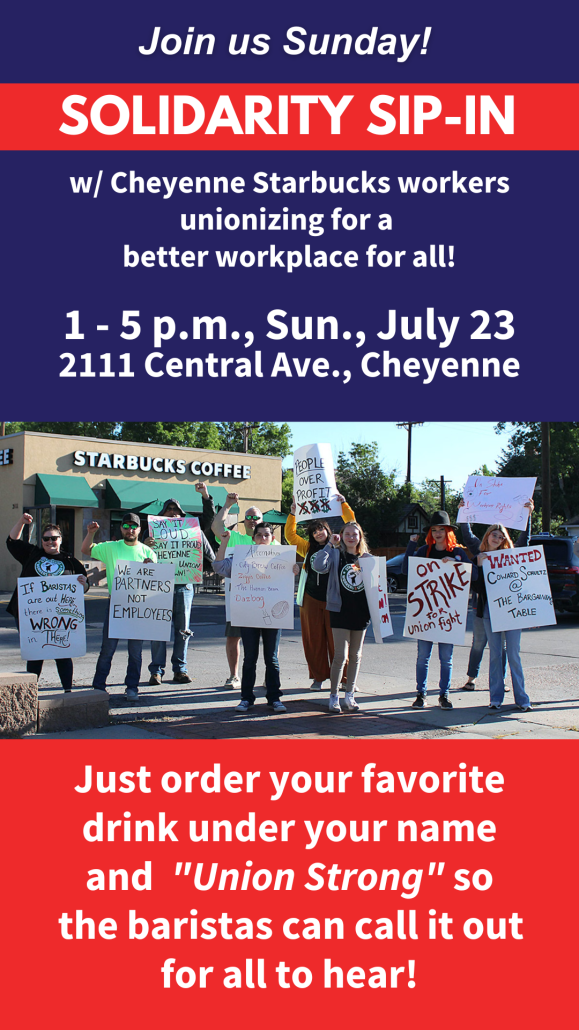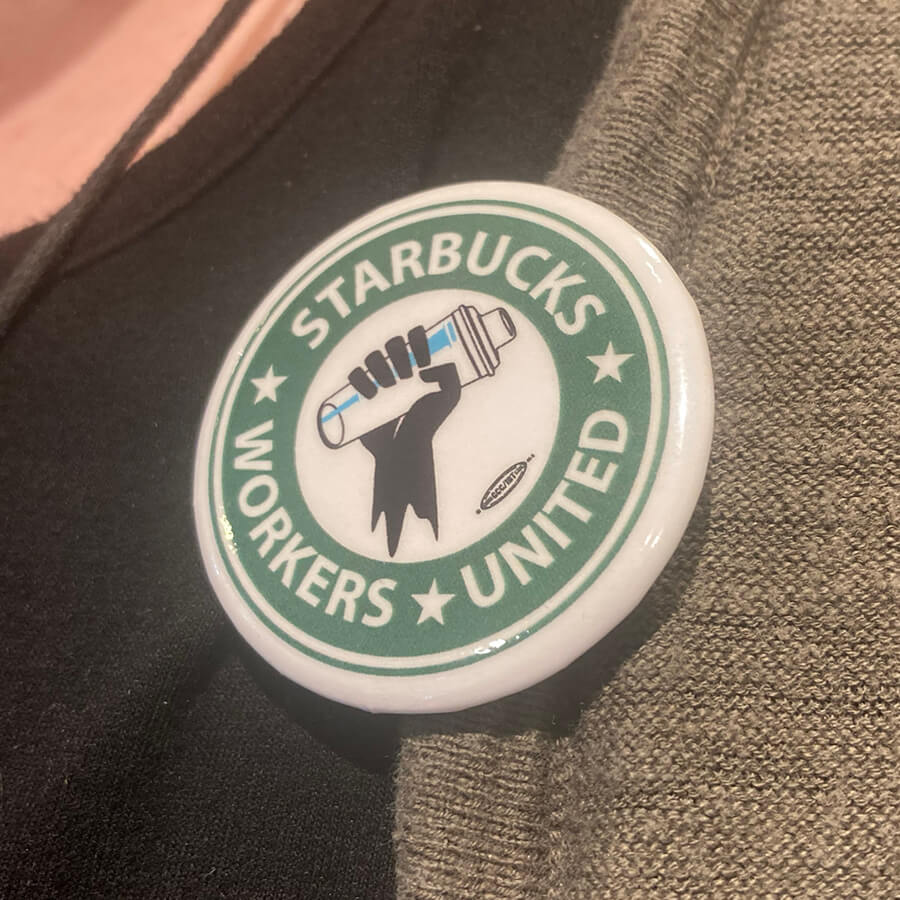It was cool inside the air-conditioned Starbucks on Central Avenue in Cheyenne last Sunday, even as the heat sweltered outside.
A dozen or so people milled about, waiting for their orders or enjoying an afternoon drink.
“What’s the name on the order?” a 20-something barista asked a customer who wanted an iced coffee.
“Union strong!” the middle-aged man replied with a smile before giving his real name.
The barista returned his grin.
The Central Avenue Starbucks employees were hosting a “Solidarity Sip-In,” a low-key afternoon event to demonstrate public support for the staff’s effort to unionize.
Nearly all of the customers in the store at that moment were there for the occasion, happy to let the workers know that the people of Cheyenne had their backs.

Erratic hours and uneven discipline from management were among the specific complaints the baristas gave in their rationale for wanting to organize. But the Cheyenne workers’ efforts come amidst an uptick of unionization across the U.S.—and, to an extent, Wyoming.
Baristas at more than 340 Starbucks locations in 40 states have banded together in recent years as Starbucks Workers United, a union that now represents more than 8,500 workers.
On Monday, July 31, staff members at the Central Avenue Starbucks in Cheyenne will hold an official vote on whether to become the first location in Wyoming to join.
Last Sunday, at the Solidarity Sip-In, the prospect of a massive Teamsters strike of UPS drivers still loomed, and new workers around the state—from Yellowstone National Park Rangers to Fremont County ambulance drivers—were signing their union cards.
For the customers at Starbucks, it was hard not to feel a sense of something afoot among Wyoming workers deciding to organize for their own good.
Power to create a better workplace
Christy Frakes is a shift supervisor at the Central Avenue Starbucks in Cheyenne who has worked at the store for 10 years. She is a full-time employee, but she told Better Wyoming she supports the unionizing effort in solidarity with her coworkers who have had their hours dramatically cut.
Frakes explained that several staff members had their hours slashed in half after the 2022 holiday season. This has happened before, but unlike years’ past, their hours were not restored in the spring when customer traffic picked back up.
The corporate office has complained that the Central Avenue location has not generated enough profits, Frakes said, even though Starbucks corporate pulled in a record-shattering $8.7 billion in profits during the most recent quarter thanks to “high prices and efficiencies.”
“This is a multi-billion corporation, and their profits aren’t going down,” Frakes scoffed.
Meanwhile, Frakes and other workers allege that local management arbitrarily punishes or cuts the hours of some employees, while protecting their “favorites” even when those employees make egregious mistakes.
Frakes and others believe that organizing as a union will help give workers power to ensure a more stable schedule and a positive workplace.
A map of all union Starbucks in the United States
Discouragement and support
Starbucks has not sad idly by and simply watched its stores unionize across America. In fact, the corporation has undertaken one of the most vicious union-busting campaigns in recent memory.
It has been found guilty of 16 labor violations by the National Labor Relations Board, and has been accused of scores of illegal union-busting tactics—from firing employees who support unions to intimidation to frivolous SLAP lawsuits.
“They want you to be divided, and they want you to be scared of losing your job. It’s just good old-fashioned Starbucks union-busting baloney.”
Frakes said that their efforts have not gone unnoticed by Starbucks corporate offices.
“A couple of regional managers have visited the Cheyenne store and tried to ‘gently’ dissuade us, like telling us if you unionize, these things you are accustomed to are going to be slower or won’t happen, and it’s not true,” Frakes said.
“They want you to be divided, and they want you to be scared of losing your job,” she added. “It’s just good old-fashioned Starbucks union-busting baloney.”
Meanwhile, the Central Avenue Starbucks workers have received plenty of support. Frakes said Starbucks union members in Tennessee and Colorado have helped the local store in its organizing effort, and some even came to a one-day “strike” outside the business in June after 11 workers signed union pledge cards.
Other local unions are showing solidarity with the Cheyenne Starbucks store, as well. Members of the Wyoming AFL-CIO, Wyoming Education Association, the International Brotherhood of Electrical Workers have all attended Solidarity Sip-Ins at the Central Avenue location.
Union activity in a “right to work” state
Tammy Johnson, executive director of the Wyoming AFL-CIO, said the Starbucks baristas in Cheyenne were not the only workers organizing around the state.
Others include the Yellowstone National Park rangers, who approved joining the National Federation of Federal Employees last week by a 66-15 vote. Johnson said a similar effort will be launched in Grand Teton National Park.

In March, the Frontier Ambulance EMS of Fremont County voted to join the United Steelworkers, with a 90 percent approval rate. The union and the company are now in contract negotiations.
“It will mean higher pay and better working conditions for EMS workers in Fremont County,” Johnson said.
Many people know that Wyoming is a “right to work” state, which Johnson said creates a lot of popular misconceptions about organized labor, including leading people to believe that unions are illegal.
“All it means is that you cannot force someone to join your union in order to work,” Johnson said. “For those people who don’t want to join a union, there you go. For those who want to form a union, AFL-CIO is here to help them.”
Johnson said she hopes the Cheyenne Starbucks workers will inspire union efforts for other Wyoming restaurant employees, who have “unconscionably low wages and an inability to collect their earned tips in many cases.”
Workers joining together to demand better working conditions and higher wages is one path toward better pay in a state that has refused to raise its minimum wage for decades.

